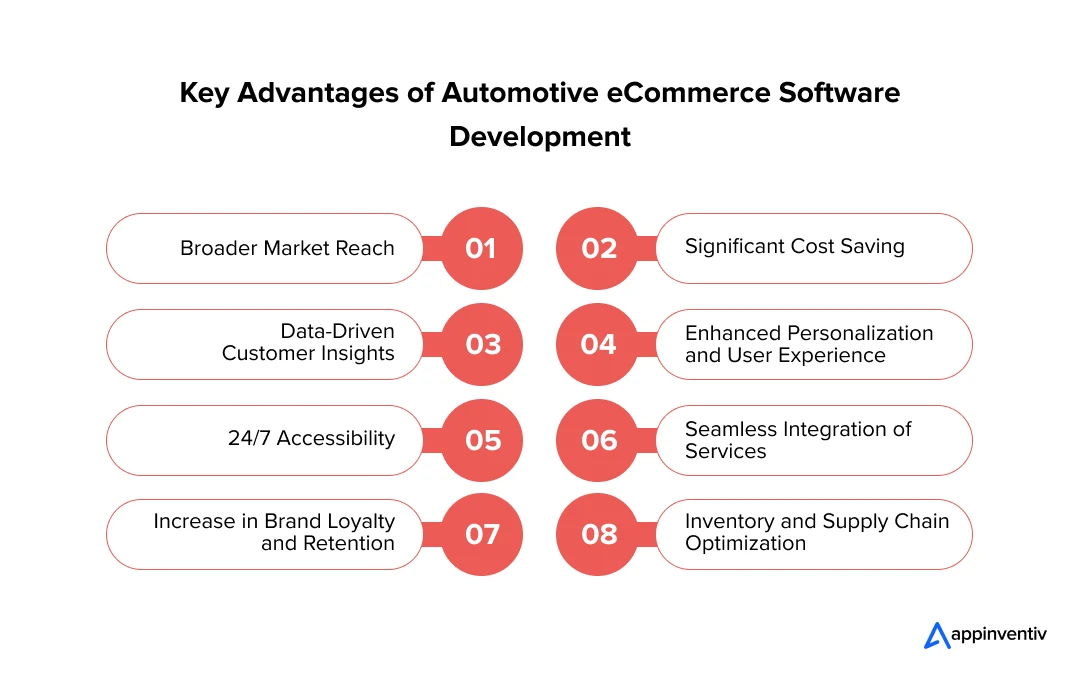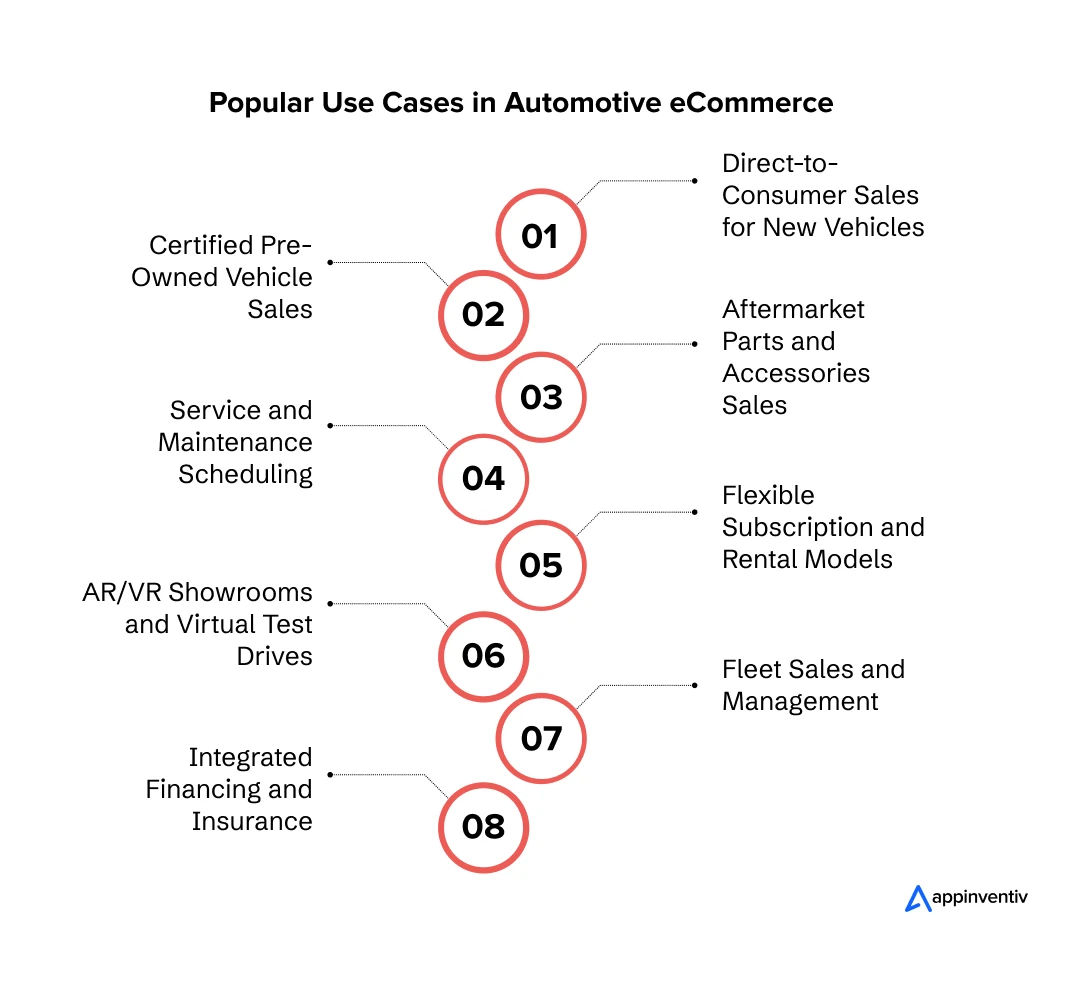- Why is the Automotive Industry Expanding to Online Sales
- 1. Changing Consumer Behavior and Expectations
- 2. Digital Transformation in the Automotive Industry
- 3. Cost and Operational Efficiency
- 4. Enhanced Consumer Confidence and Trust
- 5. Shift Toward Electric and Sustainable Vehicles
- Extensive Benefits of Automotive eCommerce Software Development
- Comprehensive Use Cases in Automotive Ecommerce
- Cost of Automotive eCommerce Software Development
- Addressing Common Challenges in Automotive Ecommerce
- Key Trends and Future Outlook for Automotive Ecommerce
- 1. Augmented Reality and Virtual Reality Enhancements
- 2. AI and Machine Learning: Automation and Smarter Insights
- 3. Blockchain for Transparent Transactions and Security
- 4. Green and Electric Vehicles – Expanding Options
- FAQs
Imagine walking into a traditional car dealership, greeted by a salesperson who asks you a few questions about what you’re looking for. You might browse through rows of vehicles, each with different features, colors, and prices. The process feels long, often overwhelming, and at times, you may leave feeling uncertain about the best choice.
Now picture this experience happening entirely online. You can browse through virtual showrooms, compare hundreds of models, check user reviews, and even customize your vehicle – all from the comfort of your home. The decision-making process becomes quicker, more transparent, and far less stressful, doesn’t it?
This is the promise of automotive ecommerce platform development: revolutionizing the way cars and car parts are bought and sold, connecting the traditional brick-and-mortar model to an online, seamless experience. With the rapid advancements in digital technologies, ecommerce platforms are transforming the automotive landscape, creating new opportunities for businesses and consumers alike. The convenience, flexibility, and personalization that online sales offer are quickly becoming the new standard in the industry.
The global automotive ecommerce market is projected to grow significantly, with an expected increase from $100.14 billion in 2024 to $343.13 billion by 2032. This explosive growth highlights how quickly the sector is adapting to changing consumer expectations. Shoppers are increasingly turning to online platforms for everything from vehicle purchases to parts and accessories, and the market is evolving in response to this demand.
This article serves as a comprehensive guide to understanding automotive ecommerce software development, including its benefits, use cases, challenges, and strategies for boosting sales in this rapidly growing industry.
Why is the Automotive Industry Expanding to Online Sales
The need to connect offline and online automotive sales has been gaining momentum for several years, driven by a number of key factors that are reshaping consumer behavior and expectations. Here are some of the primary reasons why automotive ecommerce platforms are going mainstream.

1. Changing Consumer Behavior and Expectations
Consumers today are accustomed to the convenience of online shopping for a wide range of products. From books and electronics to groceries and apparel, the digital marketplace has become the go-to platform for buying nearly everything. Cars are no exception. The modern car buyer is increasingly looking for a more convenient and transparent buying experience that they can access from anywhere, at any time. eCommerce automotive meets this need by offering:
- 24/7 Availability: Unlike traditional dealerships, which operate during set hours, online platforms are available around the clock, allowing customers to browse, compare, and purchase vehicles (usually after getting the driving experience from the offline store) at their convenience.
- Ease of Comparison: Shoppers can compare different models, prices, and features with just a few clicks, making it easier to find the best deal without feeling pressured by salespeople.
- Information Accessibility: Detailed specifications, virtual showrooms, user reviews, and video demonstrations are all available online through automotive ecommerce software, empowering customers with the knowledge they need to make informed purchasing decisions.
2. Digital Transformation in the Automotive Industry
The rise of digital technologies has made it easier for automotive companies to offer online solutions that mirror the offline experience. Through augmented reality, virtual reality, IoT, and artificial intelligence platforms, customers can get a highly interactive and personalized experience without ever stepping foot in a dealership.
- Virtual Showrooms and Test Drives: With AR and VR, customers can experience vehicles in a 360-degree view or even simulate test drives, making the experience given by automotive ecommerce solutions more immersive and realistic.
- AI-Driven Recommendations: Another key automotive ecommerce trends – Machine learning and AI algorithms – are used to personalize the shopping experience by suggesting vehicles, parts, and accessories based on customer preferences and browsing history.
[Also Read: Automotive digital transformation – Benefits, applications and challenges]
3. Cost and Operational Efficiency
For businesses, moving to ecommerce can significantly reduce operational costs. Traditional dealerships require substantial investments in physical infrastructure, showroom spaces, inventory management, and a large sales force but by opting for e-commerce market in automotive, automakers and dealerships can:
- Lower Overhead: Without the need for a range of physical showroom spaces, businesses can redirect resources to improving the digital experience and reaching a broader audience through targeted online marketing campaigns.
- Streamlined Inventory Management: Automotive e-commerce market offers better inventory tracking, allowing businesses to offer a wider selection of vehicles without the burden of maintaining physical inventory on-site.
- Global Reach: Another one of the automotive ecommerce use cases lies in the online platforms allowing businesses to reach a global audience without geographic limitations, offering vehicles to customers in different regions and even countries.
4. Enhanced Consumer Confidence and Trust
Buying a car is a major financial decision, and many consumers still feel uncertain about purchasing a vehicle online. However, the merger of ecommerce in automotive industry can build consumer trust by offering:
- Transparent Pricing: Online platforms often offer more competitive pricing and better transparency in terms of pricing models, fees, and financing options.
- Customer Reviews and Ratings: A wealth of user-generated content, such as reviews, testimonials, and ratings, helps potential buyers make confident decisions based on the experiences of others.
- Flexible Return Policies: Many players in the automotive e-commerce market now offer return or exchange policies, allowing buyers to have peace of mind knowing they can change their decision if the car isn’t the right fit.
5. Shift Toward Electric and Sustainable Vehicles
The growing demand for electric vehicles and sustainable transportation options has further accelerated the shift toward automotive ecommerce software. Consumers interested in EVs and hybrid models are more likely to use online platforms to compare different models, check specifications, and read customer reviews about their performance and reliability.
And the e-commerce market in automotive has been quick to respond by offering a broader range of green and eco-friendly vehicles, making it easier for consumers to find options that match their values and preferences.
[Also Read: How EV technology is tackling key barriers to electric vehicle adoption]
The connection between offline and online automotive sales is not just a passing trend; it’s a result of shifting consumer behavior, technological advancements, and the demand for greater convenience. By adapting to these changes, businesses can cater to a new generation of car buyers while improving their own operational efficiency.
This transformation has brought with itself a range of benefits that doesn’t just improve buyers’ experience but also companies’ profitability.
Extensive Benefits of Automotive eCommerce Software Development
eCommerce in the automotive industry can deliver unparalleled opportunities for scalability, efficiency, and customer engagement. Here’s a closer look at them and several other key benefits:

Broader Market Reach
Traditional dealerships often attract only local customers but ecommerce removes geographical constraints, opening access to nationwide and even global audiences. For example, an online car store can attract buyers from multiple states, growing brand exposure and diversifying customer demographics.
A real-world case for this can be seen through Carvana, launched in 2013, the used cars marketplace recently celebrated its 4 million cars bought and sold benchmark!
Significant Cost Savings
Robust ecommerce platform development can reduce expenses related to property, staffing, and maintenance. While establishing a dealership requires large real estate investments and upkeep, a virtual showroom offers a more sustainable model with significantly lower overhead.
Data-Driven Customer Insights
Online shopping platforms capture rich data on customer behavior, preferences, and trends, providing powerful insights for data-driven decisions. For instance, by working on automotive ecommerce use cases around tracking, even the most viewed car models or features can be identified, which can ultimately help in stocking preferences and targeted marketing.
Enhanced Personalization and User Experience
Ecommerce platforms enable highly customized customer experiences, allowing users to explore models, configure features, and visualize their ideal car before purchase. This capability can foster an emotional connection to products, boosting engagement and satisfaction.
An example of this can be seen through the Tesla Shop, which allows customers to customize Model S and have the car delivered to their home.
24/7 Accessibility
Unlike physical dealerships that operate within limited hours, ecommerce automotive industry is open around the clock. This accessibility allows users to browse, research, and make decisions at their convenience, a crucial advantage for busy professionals.
Seamless Integration of Services
One of the main automotive ecommerce trends can be seen in automotive ecommerce platforms integrating ancillary services such as financing, insurance, and trade-ins directly into the customer journey. These features streamline the process, allowing customers to complete all necessary steps in one place.
Increase in Brand Loyalty and Retention
It is a known fact that engaging content, personalized recommendations, and loyalty programs can boost customer retention. So when platforms send regular email marketing campaigns, such as maintenance reminders or exclusive offers, the benefits of automotive ecommerce software development come on the forefront through the way of helping create long-term customer relationships.
Inventory and Supply Chain Optimization
Online sales data can assist with smarter inventory management and supply chain decisions. Also, tracking demand and sales trends which becomes much easier through the inclusion of AI or ML in the ecommerce platform helps businesses adjust stock levels more efficiently, reducing holding costs and ensuring faster turnover of popular models.
This can be understood better with Ford’s example where the brand uses artificial intelligence to automate quality assurance. Its AI can detect wrinkles in car seats, while the neural networks help support Ford’s supply chain through inventory and resource management.
Ford also uses AI technology to understand the inventory data for used cars with an artificial intelligence platform called CarStory.
Comprehensive Use Cases in Automotive Ecommerce
Automotive e-commerce market is versatile, catering to diverse functions beyond just selling new cars. Here are key use cases that are shaping the market and which can be explored by businesses looking to make it big in the domain.

Direct-to-Consumer Sales for New Vehicles
Many automotive companies now leverage DTC ecommerce, bypassing traditional dealerships. This approach gives them full control over the customer experience and allows for direct feedback, better profit margins, and streamlined logistics.
Certified Pre-Owned Vehicle Sales
The sale of CPO cars has become a critical aspect of automotive in ecommerce. Detailed inspections, warranties, and a robust history report help to build customer confidence, increasing the appeal of purchasing pre-owned vehicles online.
Aftermarket Parts and Accessories Sales
Selling parts and accessories directly through an ecommerce platform caters to both DIY consumers and professional mechanics. These automotive ecommerce software can offer everything from custom car accessories to essential parts, expanding revenue streams.
Service and Maintenance Scheduling
Many platforms now enable customers to book service appointments online. This convenience, combined with automated reminders for maintenance intervals, helps foster long-term customer relationships and drive ancillary revenue.
Flexible Subscription and Rental Models
Subscription services allow customers to access vehicles for a set period, appealing to those who want flexible, short-term commitments. Powered solely by automotive ecommerce platforms, businesses can enable seamless booking, management, and payment, enhancing user convenience.
AR/VR Showrooms and Virtual Test Drives
Virtual and augmented reality in ecommerce allow users to explore a vehicle’s interior, exterior, and customizable options from home. By simulating a showroom experience, AR/VR creates an immersive interaction, increasing customer confidence in their choices.
Fleet Sales and Management
eCommerce automotive is also suited to B2B customers needing fleet vehicles. An ecommerce portal which streamlines ordering, maintenance tracking, and financing, can save businesses time and simplify logistics.
Integrated Financing and Insurance
Offering integrated options for financing and insurance simplifies the customer journey and keeps them on the platform longer. These ecommerce automotive industry platforms can provide tailored loan rates and insurance options, helping customers complete their purchases with minimal friction.
Having worked with a range of automotive ecommerce software use cases, there’s one thing which is very clear to us. The space is still waiting for digitalization – there’s too much to explore. However, this exploration does come with a price tag and while it is nearly impossible to give you that price tag without looking into your idea, here’s a rough view of the automotive ecommerce platform development cost.
Cost of Automotive eCommerce Software Development
Developing a comprehensive automotive ecommerce platform involves several stages, each with associated costs. The primary stages of the automotive ecommerce platform development process along with their approximate costs include:

Research and Strategy
The research phase involves understanding the target market, consumer behavior, and competitors. It also includes defining the platform’s features, UX/UI design requirements, and integration with third-party services like payment gateways and CRM systems.
- Estimated Cost: $5,000 – $50,000
Design and Development
The design and development phase focuses on building the ecommerce mobile application or website. This involves user interface design, user experience design, and coding the platform’s backend.
- Estimated Cost: $15,000 – $150,000
Quality Assurance and Testing
After development, extensive testing is needed to ensure the platform functions as expected. This includes testing for usability, security, performance, and compatibility across devices.
- Estimated Cost: $5,000 – $30,000
Marketing and Launch
Once the platform is ready, businesses must invest in marketing strategies to promote the ecommerce platform, including SEO, PPC advertising, social media campaigns, and influencer partnerships.
- Estimated Cost: $5,000 – $100,000
Ongoing Maintenance and Updates
Maintaining the ecommerce platform, adding new features, improving security, and updating product information are continuous costs.
- Estimated Cost: $5,000 – $30,000 per year
This was a rough idea of what a typical automotive ecommerce platform development cost can look like – $35,000 – $360,000+. But this range can be very different from the cost of bringing your concept to life. To know what that cost range can be, get in touch with our team of our automotive software development services providers.
Another key aspect that also indirectly impacts the automotive ecommerce platform development process and cost are the roadblocks.
The unique challenges that the ecommerce market in the automotive industry brings with itself are tackled by ecommerce software development services providers by expanding the cost range or timeline. But that is not the case with us. At Appinventiv, we plan for the challenges right at the discovery stage of the automotive ecommerce platform development process, leaving minimal scope for last minute surprises.
Addressing Common Challenges in Automotive Ecommerce
Building a successful automotive ecommerce platform isn’t without hurdles. Hurdles that come from both the development and business model side of things. Here’s a closer look at common challenges and strategies we generally use, suggest to tackle them:

- Complex Product Descriptions: Detailed, easy-to-understand vehicle descriptions are necessary to help customers make informed decisions. Interactive multimedia and AR features can enhance engagement.
- Customer Trust and Transparency: Online car purchases can trigger skepticism. Virtual tours, third-party inspections, and transparent return policies can help foster trust to avoid this situation.
- Logistics and High Shipping Costs: Shipping vehicles or heavy parts can be costly. Clear policies, partnerships with logistics providers, and streamlined return processes minimize this challenge.
- Data Security and Compliance: Automotive ecommerce platforms must safeguard sensitive data. To solve this, building secure payment gateways and adhering to regulatory standards becomes essential for user confidence – something we keep on top priority in our automotive ecommerce software development process.
- Competition and Customer Retention: SEO strategies, targeted ads, and loyalty programs are key to standing out in a crowded market and building a base of repeat customers. To achieve this, we usually build a CMS in the platform for easy content generation and deployment.
[Also Read: Customer loyalty and rewards app development – Benefits, process, costs]
In addition to our hands-on approach when it comes to solving challenges proactively, there’s one more reason why automotive industry players who are out to digitalize their shopping experience choose us – our market understanding.
At Appinventiv, we carry a deep level understanding of what works in the automotive ecommerce space and how the industry would move to become the future of automotive ecommerce.
An expertise that can be measured through our efforts that resulted into a used engines eCommerce platform seeing its conversion rates jum from 1.8% to 4.5% within six months in addition to the platform being able to reduce order processing times by 60%, ensuring faster dispatch and delivery.
While this is about automotive, we have already established our name in the ecommerce space by working on notable projects like Adidas, 6th Street, and Edamama.
Driven by our combined subject matter expertise in automotive and ecommerce, otive, let us tell you what we foresee happening.
Key Trends and Future Outlook for Automotive Ecommerce
As automotive ecommerce continues to evolve, staying ahead of the latest trends and technologies will be essential for businesses looking to maintain a competitive advantage. Here are some of the most influential trends shaping the future of automotive ecommerce:
1. Augmented Reality and Virtual Reality Enhancements
The use of AR and VR is revolutionizing how customers interact with products online, particularly in the automotive sector. These technologies allow potential buyers to explore cars in greater detail than traditional images or videos allow.
- Virtual Showrooms: Virtual showrooms provide a fully immersive experience, allowing customers to view cars from all angles and even explore interior features, color options, and customization possibilities.
- AR Test Drives: Augmented reality can simulate a real-life test drive experience, allowing users to experience the feel of a vehicle through a smartphone app or desktop.
- Customization Tools: AR and VR tools let customers configure their vehicles, choosing colors, trims, wheels, and other options in a virtual environment before making a purchase.
2. AI and Machine Learning: Automation and Smarter Insights
AI is set to continue playing a major role in automotive ecommerce, especially in terms of automation, personalization, and predictive analytics. In the time to come, we will see more machine learning models coming into existence to anticipate customer needs based on past behavior and preferences.
- Predictive Maintenance: AI-powered analytics will be used to predict when vehicles need service or when a part is likely to fail, prompting customers to book service appointments directly through the ecommerce platform.
- Enhanced Search Capabilities: AI will enable more advanced search functionality, allowing users to search for cars or parts based on specific attributes, preferences, or budget constraints.
- AI-Powered Chatbots: Chatbots using natural language processing can answer customer queries and guide them through the entire purchasing process, from browsing to payment.
3. Blockchain for Transparent Transactions and Security
Blockchain technology offers a secure, decentralized way to handle transactions and protect customer data. In automotive ecommerce, blockchain will be used for several key purposes:
- Secure Payments: Blockchain allows for faster and more secure transactions by eliminating intermediaries and providing immutable transaction records.
- Vehicle History and Ownership Tracking: Blockchain can offer a transparent, tamper-proof record of a vehicle’s history, ownership, and maintenance records, which can increase customer confidence in pre-owned or certified vehicles.
- Smart Contracts: Automating aspects of the buying process, like financing or insurance, through smart contracts can speed up transactions and reduce errors.
4. Green and Electric Vehicles – Expanding Options
With the growing demand for environmentally friendly vehicles, automotive ecommerce platforms will increasingly offer more electric vehicles and hybrid models. Online platforms that highlight eco-friendly options will appeal to a broader audience of consumers interested in sustainability.
- EV-Specific Features: Offer detailed comparisons between EVs, including range, charging time, and environmental benefits, to help customers make informed decisions.
- Partnerships with EV Manufacturers: Collaborate with leading electric vehicle manufacturers to feature exclusive models and give customers more options in the fast-growing EV market.
At this point, I am sure you must have understood how critical yet untouched ecommerce in the automotive industry currently is. The potential to enter and ace the domain is still ripe and ready for new entrants who have a market viable use case. We can help you get there with our dedicated automotive and ecommerce expertise. Let’s talk.
FAQs
Q. How is eCommerce used in the automotive industry?
A. Bringing automotive in ecommerce enables customers to browse, purchase, and even customize vehicles online. It allows automotive companies to showcase their inventory, offer virtual showrooms, and provide detailed product information. Besides vehicle sales, eCommerce platforms are used for selling parts and accessories, scheduling services, and offering online financing options. Additionally, customers can view vehicle details, compare models, and often complete the buying process entirely online, improving accessibility and convenience.
Lastly, some manufacturers and dealerships offer augmented reality experiences, enabling users to visualize cars in their space or explore interior features interactively.
Q. What impact does eCommerce have on the automotive industry?
A. eCommerce has significantly transformed the automotive industry by broadening market reach, enhancing customer convenience, and streamlining operations.
- By moving sales and service options online, companies can reach a global audience, reduce showroom dependency, and lower operational costs.
- Customer data collected online helps personalize marketing and improve customer engagement.
- eCommerce enables a faster sales cycle, as customers can research and purchase from the comfort of their homes, reducing the need for multiple in-person dealership visits.
Overall, eCommerce has increased competitiveness, efficiency, and customer satisfaction within the automotive sector.
Q. What are the challenges with automotive eCommerce platform development?
A. Developing eCommerce for the automotive industry comes with unique challenges.
Complex product data, including specifications, models, and customizable options, requires detailed, accurate, and often updated information. Integrating systems like inventory management, payment processing, financing, and customer relationship management can be complex and costly.
Additionally, security is a top concern, as sensitive customer and payment information must be protected. Providing a seamless, user-friendly experience across mobile and desktop, while managing high-quality visuals and AR features, is also challenging. Lastly, fostering customer trust online, especially for high-value purchases like vehicles, requires robust support and transparency.



A Comprehensive Guide to Healthcare eCommerce
Imagine this: a working mother notices her child has a persistent cough. Instead of rearranging her schedule to visit a clinic, she books a teleconsultation with a pediatrician, gets a prescription instantly, and orders the medicine online - all within an hour. Meanwhile, a rural patient needing advanced medical equipment can browse through an ecommerce…

Top 10 Transforming Benefits and Use Cases of Digital Asset Management in eCommerce
Running an eCommerce business without a central hub for your digital content invites chaos. With thousands of images, videos, and product descriptions constantly flowing through your channels, managing them effectively becomes a critical challenge. This is where Digital Asset Management (DAM) shines. It’s not just about storage; it’s about giving your team instant access to…

How Much Does It Cost to Build an eCommerce App Like Jarir Bookstore?
Do you know what propels an eCommerce app from just functional to phenomenally successful? Well, the answer is the buzz it creates. This compelling mix of word-of-mouth enthusiasm that users share with friends, colleagues, and family. When customers are impressed enough to recommend your app, that's not just a win but a revenue multiplier. Now,…











